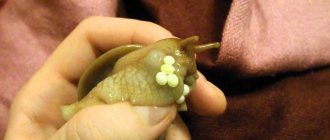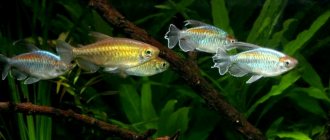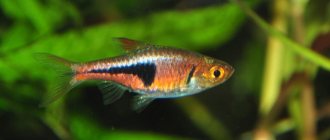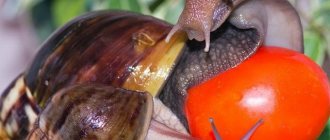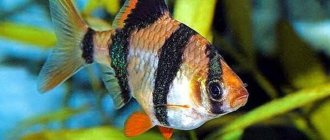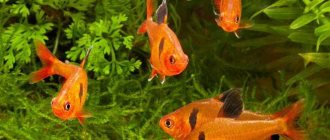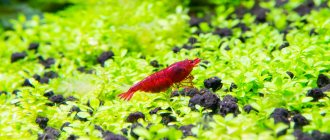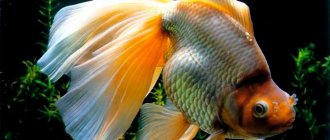The snail ampullaria is a colorful exotic inhabitant of the aquarium. It is not difficult to create suitable conditions for this pet; the main thing is to provide them with good nutrition and sufficient oxygen levels. It is thanks to its unpretentiousness and high resistance to disease that the ampoule has become one of the most popular snails among aquarists around the world.
Ampullaria snails were first discovered in the Amazon River. The tropics are their favorite habitat, since it is in this environment that snails feel most comfortable. Moreover, they can live in ponds, lakes, and canals. These exotic inhabitants are almost constantly underwater, coming to land only occasionally - to lay eggs and take in the air. The shell is their saving place, in which they lock themselves, protecting themselves from danger and unfavorable weather (most often, drought).
Aquarium snail Ampularia
Possessing a unique ability to survive in the most unfavorable conditions and strong natural immunity, a significant part of the species of ancient gastropods has survived to this day. Ampularia is no exception; even now, despite its tropical origin, it has spread quite widely in the watery territories of many countries of the world with a warm or temperate climate.
It should be noted that Ampularia is not always a desirable neighbor of human civilization in its natural habitat. By growing excessively, some populations of this snail can cause significant harm to crop fields, primarily rice fields, which create especially comfortable conditions for the reproduction of ampullaria snails, which are not averse to feasting on the ripening harvest.
The Ampularia snail settled in aquariums at the beginning of the 20th century, in Germany, where it was brought by travelers from the wetlands of the Amazonian lowland located in Brazil, Bolivia, Peru, Ecuador and Colombia.
Ampularia is considered a fairly large snail for aquariums. In stores it is sold at a size of just over 2 centimeters in diameter and it is hard to believe that in about a year it can grow to 10 centimeters.
Not all types of ampullaria are equally suitable for living in home aquariums. Some of them reach sizes significantly exceeding 10 centimeters, which requires the creation of a special habitat for them.
The common aquarium snail Ampularia has a twisted shell, usually yellow or light brown in color with dark veins. Much less common are ampularia of almost white, blueberry and almost black color.
Ampularia's eyes are yellow-golden in color. The organs of touch are small tentacles, and an acute sense of smell contributes to orientation in space. This snail moves with the help of a muscular leg that has a protective flap, closing which the ampularia not only protects its vulnerable body, but also retains moisture during a period of prolonged drought or when outside the reservoir.
Ampularia is capable of breathing both underwater and in the open air, but if it remains in only one of these environments for a long time, it can die - on land.
In aquarium conditions, with proper care, Ampularia can live up to 3 years. In the wild up to 5 years.
Table of basic parameters of maintenance, care and nutrition:
| What should be the volume of an aquarium for aquarium snails? | from 10 liters |
| What should be the temperature in an aquarium for aquarium snails? | from +20-25° C |
| What pH should be in the aquarium? | from 6.5-7.8 pH |
| What should be the hardness of the water in the aquarium? | from 8-18° dH |
| What should be the substrate for an aquarium? | coarse or fine sand; soil size from 2-4 mm |
| What kind of lighting should be in the aquarium? | moderate |
| What should be the movement of water in the aquarium? | moderate |
| Maximum snail size | up to 10 cm |
| What do aquarium snails eat? | aquarium plants; food for fish; vegetables: cucumbers, zucchini, pumpkin, carrots |
| Type of aquarium snail | peaceful |
| Who is compatible with in an aquarium? | compatible with all peaceful aquarium inhabitants |
| Lifespan of aquarium snails | up to 3 years, but it depends on the conditions of detention |
Description and types
The definition of the ampullaria snail includes a family of freshwater animals that is distributed throughout the planet. The size of the mollusk ranges from 4 to 16 cm and depends on the variety.
The average life expectancy is about 2-3 years. If the conditions are chosen correctly, the ampularia snail will live for five years.
Ampoules feel best in warm water from 20 to 25 degrees. These values are also optimal for other underwater inhabitants, therefore it is allowed to keep ampullaria snails in the same space as aquarium fish. Symbiosis will only be beneficial. Gastropods breathe through a siphon tube, but nature has also endowed them with gills. A characteristic feature of ampularia is heterogeneity. There is a lid at the mouth of the shell that protects from aggressors.
Breeders divide the types of ampullaria by their color. Colors may vary.
The most popular option is the yellow snail, but brown, pink, blue and pearl ampularia are also found.
Ampularia snail maintenance and care in the aquarium
The snail Ampularia is one of the most unpretentious aquarium inhabitants. But despite their good survival in extreme conditions - with a maximum water temperature of +30° C and a minimum of +18° C, it is still more reasonable to set the most comfortable temperature for these snails in the aquarium at +20-25° C.
Too soft water in the aquarium can damage the shell of this snail over time; medium-hard water in the range of 8-18° dH is optimal for ampullaria. The required water acidity is from 6.5-7.8 pH.
The volume of water required for normal habitat and reproduction of ampullaria is calculated based on an additional 10-12 liters per 1 snail. That is, if the total volume of water in the aquarium is already distributed among its other inhabitants and there is no required space, purchase a more spacious aquarium. Unless, of course, there is a desire to keep the apple snail in an isolated aquarium, which is unlikely to contribute to creating a snail habitat that is as close to natural as possible. This can reduce their lifespan and ability to reproduce.
Most aquarists especially value ampullaria for their ability to clean the aquarium of pathogens, destroy harmful algae, and also absorb the remains of fish food, small dead fish, and loosen the soil, which helps maintain the ecological balance of the aquarium.
Ampoules do not require additional aeration, water filtration, or aquarium lighting.
What and how to feed
The answer to the question of what to feed the ampularia snail is quite simple. Almost all types of snails in their natural habitat feed on plant foods, but in an aquarium Ampularia cannot always find traditional food sources for itself, so almost everything that falls on the ground becomes food for it.
In a short time, snails get used to eating not only the remains of fish food, but also any organic matter they come across along the way, be it a small moth, a small bottom crustacean or an earthworm.
If this is not enough for the ampullaria, they can switch to eating decorative aquarium vegetation. And if you do not provide them with vegetable feeding in a timely manner, they can cause great damage to the beneficial aquarium flora.
The ideal food is vegetables (cucumbers, zucchini, pumpkin, carrots), which need to be poured with boiling water for 5-10 minutes, and food for bottom fish. The food should be left in the aquarium for no more than a day, after which the food may begin to rot. You can feed 1-2 times a day.
Many people rightly believe that the ideal food for ampularia is food tablets for aquarium catfish, containing the very beneficial algae spirulina.
general information
The homeland of ampularia is South America. These snails are usually found in yellow, but blue, purple and even brown varieties can be found commercially. Moreover, their colors range from dark to very light. If the snail has enough food, it grows to its maximum size quite quickly . Therefore, it is best to buy small individuals, since they live in captivity for no more than two years.
In an aquarium, ampularia do not live long: no more than 2 years
The mollusk has a special cap on its shell , which quickly closes in case of danger or unfavorable conditions. Ampoules get along well with each other, so several species can be kept in one aquarium. They have a rather interesting respiratory system. The individual has gills on the right side, and lungs on the left.
The snail needs oxygen to breathe. So when she needs to pump it up, she rises to the surface and pulls out the breathing tube. Regardless of the type and color, the structure of all ampullaries is the same. They have a well-developed sense of smell, thanks to which they quickly find food in the aquarium. The mollusk has eyes in the head area, as well as four tentacles.
How to determine the sex of Ampularia
Almost all aquarists who are not highly specialized specialists in this field talk about some difficulties in determining the gender of specific specimens of ampullaria. This is especially difficult to do when buying them in a store, when the snails are still very small. But the combined experience of all owners of these snails allows us to identify the following methods for determining the sex of the ampularia:
- If the shell structure has already been formed, the sex of the snail can be determined by the direction of its curls. If they are twisted clockwise, then it is a male; if in the opposite direction, it is a female;
- If the mouth of the snail shell has a round shape, then you have a male in front of you, and if it is oblong, then you have a female in your hands;
- If you catch the moment when the snail opens the flaps of its shell (it’s easier to do this in water), then seeing a characteristic sexual process in its upper part, you can conclude that this individual is male. Accordingly, the absence of such a process will indicate the female origin of this individual.
By combining these methods of sex determination on several snails, it is possible to separate males from females with a fairly high degree of probability.
Aquarium snail Ampularia reproduction
Ampullaria reach sexual maturity at the age of about 1 year. No special measures are required to stimulate mating of these snails. Their natural instinct is as strong as that of all representatives of the animal world. And the reproduction of ampullaria in captivity is no different from their reproduction in natural conditions.
Some short time after mating, the fertilized female crawls out of the water and lays eggs above the surface of the water (4-5 cm above the level), in a secluded place that is most comfortable for laying. Caviar is never laid by ampularia under water, since the fruits require a constant supply of oxygen. In addition, exposure to air allows the eggs to acquire a fairly dense shell, which makes them more protected.
It takes from 2 to 4 weeks for the eggs to ripen, depending on the temperature and humidity characteristics of the air. Newborn snails hatch fully formed and do not require any special care. It is only necessary to prevent the chaotic spreading of small snails in time by collecting them in an aquarium and covering them with a special aquarium lid.
An important note: the survival rate of newborn snails in a general aquarium does not exceed 10%. Therefore, if you need to preserve the maximum number of snails, you need to place them in a separate aquarium while they grow (up to 2 centimeters).
Creating suitable conditions
Snails breed during the warm season. Sometimes ampullaria lay eggs in winter, but such cases are the exception rather than the rule.
After mating is complete, the female crawls out and places the eggs on the wall of the aquarium. All eggs in the clutch fit tightly to each other. Caviar looks like small balls of delicate pink color. The size of one egg does not exceed two millimeters. The average diameter of the masonry is 2x4 cm.
The ampoule snail lays eggs on the lid of the aquarium because... masonry requires atmospheric air.
The masonry is always at a certain height, without access to water. In nature, snails thus protect future offspring from aquatic inhabitants. But at home, the ampoule, in search of a good place to lay it, can lift the glass lid and crawl out. If it is not noticed in time, the animal may die from lack of moisture. For this reason, the aquarium with ampularia is carefully closed.
It is important to note that ampularia is rarely limited to one clutch. After mating, the female can lay eggs three to five times with a break of several days.
Compatibility with fish
It is not recommended to stock ampullaria with some types of aquarium fish, especially predatory ones.
Small viviparous fish, for example, most species of aquarium catfish, will not cause any harm to ampullaria, while some species of tetradons, cichlids and barbs (it is impossible to list them all) can over time completely destroy the entire aquarium population of ampullaria.
Most species of small predatory fish will not be able to cause serious harm to adult snails, but growing ampullaria can be completely destroyed. Although adult snails will not feel at ease, being subjected to constant attacks from unfriendly neighbors in the aquarium, and receiving injuries of varying degrees of severity from them.
Aquarium snail Ampularia disease
As already noted, over the hundreds of millions of years of their existence, ampullaria have acquired an increased ability to survive in the most negative conditions and strong immunity to various diseases. However, they, like everything that lives on earth, periodically get sick.
Falling into a coma
Due to the lack of oxygen in the water and the overcrowding of the aquarium, ampullaria may fall asleep deeply and not emerge from under their shell. A prolonged stay in such a coma can lead to the death of the snail.
To bring the ampularia out of a coma, it must be temporarily moved to a separate tank with clean water enriched with oxygen. In most cases, the snail recovers from its coma within a few days.
The appearance of flaws on the sink
The snail's shell softens and becomes defective due to prolonged exposure to excessively soft and warm water (above +25° C).
To restore the structure of the Ampularia shell, it is necessary to reduce the water temperature in the aquarium to 20-22 ° C for at least 3 months, and also ensure the required water hardness of 8-18 ° dH. And add calcium to the water, which you can buy at the pet store. Due to its high ability to regenerate, the snail's shell will have to recover.
The appearance of holes in the sink
Holes on the shell are the result of the inattention of the owner of the aquarium, who missed the moment when flaws appeared on the snail’s shell.
Having restored all the water characteristics required for keeping the ampoule, you will have to wait a long time for the holes to heal. To speed up the regeneration process, it is recommended to feed snails with special food with a high calcium content.
Overgrowth by parasites
The appearance of parasites in an aquarium, especially one densely populated with various living creatures, is highly probable and unpredictable.
If a white coating appears on the snail, it is recommended to place it in a saline solution (15 grams per liter of water) for 10-15 minutes. This saline solution will cause absolutely no harm to Ampularia, and the parasitic plaque will be destroyed.
We hope that the article answered questions about ampullary maintenance, feeding, sex determination, reproduction, compatibility with fish and possible diseases.
Feeding
If snails live with fish, then they do not need special food. They will happily eat leftover fish food, dead plant leaves, and dead fish. They are fed with catfish tablets, vegetables scalded with boiling water (zucchini, pumpkin, cucumber), bloodworms, and tubifex.
Ampularia happily eat tender live plants planted in the aquarium. To prevent this from happening, give them spirulina.

